
A daughter documents her mother’s decline and the Hindu rites around death and mourning
In the dead of the cold winter of January 2012, my spiritual guide, my mother, flew from Mumbai to New York City so she could hold my hand as I birthed my daughter. That same week I started to note that my passionate, expressive mother seemed uncharacteristically distant, unusually detached, and unpredictably moody for a new grandma. In the six months that followed, my mother’s brilliant mind completely disassembled. At the age of sixty, Kiran Sharma was diagnosed with an early onset of Frontotemporal Dementia. She quickly lost her ability to speak, and my father’s singular purpose became to provide her with selfless home care.
As I navigated the cruel timing of my mother’s illness in parallel with my new motherhood, I began to make pictures of what was unfolding before my eyes. I would grip my camera, draw it close to my face, cradle its familiar contours so I could depress the trigger, and freeze everything at will. This ritual comforted me. I knew I couldn’t change my mother’s destiny, but sometimes the act of taking a photograph cheated me into believing that I was slowing it down.
I believed in my heart like a desperate fool that if my mother could speak, she would reveal all the great wisdom she was accumulating. My guru, after all, had to be leaving me some signs about her silver lining. If I looked hard enough through the camera and within the photographs, I thought I might find the clues. I practiced my ritual during every trip to India over the course of ten years.”¯
My interest in ritual was inspired by the teachings of my mother, who was deeply invested in her spiritual development. She believed that we as individuals are miniatures of the universe itself.
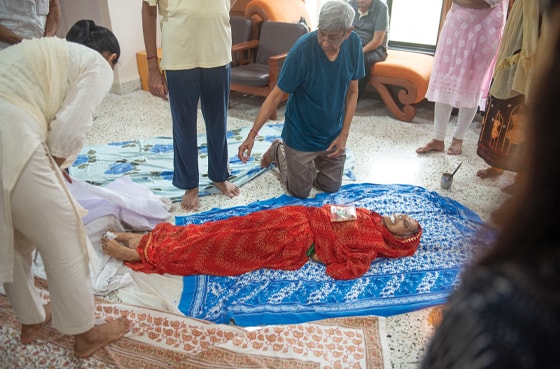
The goal of her practice was to experience this divine synchronicity within and beyond. She read, meditated, chanted, and practiced yoga. She was chasing a soul awakening that would liberate her from material attachment and bestow upon her freedom from the karmic cycle of rebirth.
After a decade-long battle with the disease, my mother took her last breath on August 9, 2022.”¯
As per the Garuda Purana, a sacred Hindu text that addresses issues of death, funeral rites, and the metaphysics of reincarnation, after a death the family enters a period called sutak, or mourning. They renounce daily life activities for twelve days.
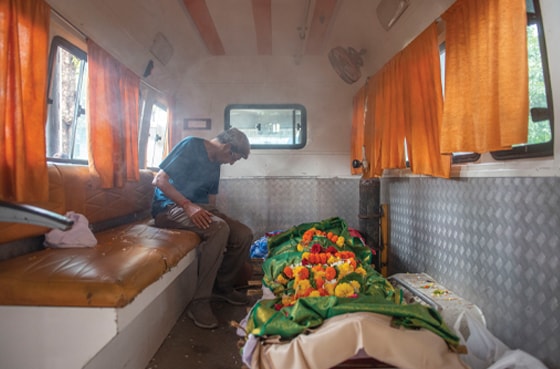
Hindu culture believes that a part of a person lives on after their death. To ensure that this part enters the land of the dead, the descendants must perform the necessary ceremonies. On completion of these rituals, the dead gain the status of pitru, or ancestor. Otherwise they remain in the land of the living as preta, a ghost hunting for closure.
On the first day we bathed my mother’s body and placed it on the ground with her head pointing north and feet pointing south. Since my father was alive, my mother was still a married woman, which meant she would leave this world just as she was decorated as a bride. My aunts draped my mother in a red and gold saree and bejeweled her with a red bindi on her third eye. Then my dad dropped down to the floor to put a mangal sutra, a necklace and symbol of marital status, around her neck. The only other time he performed this ritual was at their wedding.
According to the Indian conception of the universe, the cosmos is a continuum. Like a circle or a void, the universal order presents in uninterrupted continuity. While there are phases in this order, no phase is absolute in itself. Each contains all the parts of the whole. The significance of a ritual at all levels is holistic.”¯
Preparations for the shav yatra, journey of the deceased, entailed building a ladder-like contraption with bamboo and rope, which became the bed for my mother’s body to be carried to the ambulance. During a small prayer ceremony, we showered my mother with shawls to keep her body warm and garlanded her many times so she would remain surrounded by fragrance.
In the ambulance, the pandit (priest) gave me a handful of flowers, holy basil, rice puffs, and small sugary treats to throw out of the window. Watching those flowers blow and wither away into the wind felt appropriate. This custom occurs so other restless spirits that may envy the procession feel validated and honored.”¯”¯”¯
The enactment and performance of these death rituals propelled me toward an unexpected spiritual state. I felt a synchronicity, a oneness with the universe, and it did not descend from “above” but rather felt like an illumination or a swell from within.
The chief goal of ritual worship is to experience this order. To feel the interrelation of all phenomena, or to transition from an egocentric to a cosmocentric outlook by merging the self into the whole through a dynamic process of awakening.
The greater the intensity of the ritual experience, the higher the spiritual growth will be until the cycle of birth, death, and rebirth comes to an end. Ritual has the power to vanquish the fear of death and transcend death in the experience of life’s unity
At the cremation ground, there was a prayer and set of rituals to prepare my mother’s body so the flames would graciously receive her. We layered her with ghee and sandalwood shavings, and decorated her body with the three types of ayurvedic old-world perennial grasses representing purity, rejuvenation, and immortality.
The pandit made a hole in a clay pot filled with water, which my brother carried on his shoulder. My brother circled our mother as the water drained from the pot. I grew up watching this ritual in Bollywood movies, yet suddenly it carried meaning like never before. It felt tribal. With every circle my brother drew with his body around my mom, I thought of her life, womb, birth, and death.”¯
Antiyesti, or cremation, means the “last sacrifice.” We give ourselves and our bodies to the fire, which is the eternal host of all human beings. This is the last of the Hindu sacraments designed to ensure the journey of the departed soul in the next world.
Despite all the wisdom my mother imparted to me through her spiritual quests, nothing in my life could have ever prepared me for when the flames took my mother’s body. The finality of that moment was unbearable.
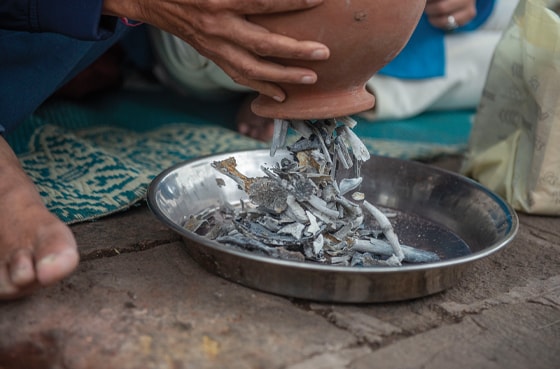
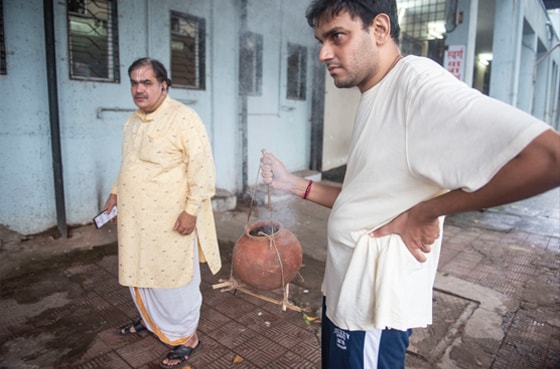
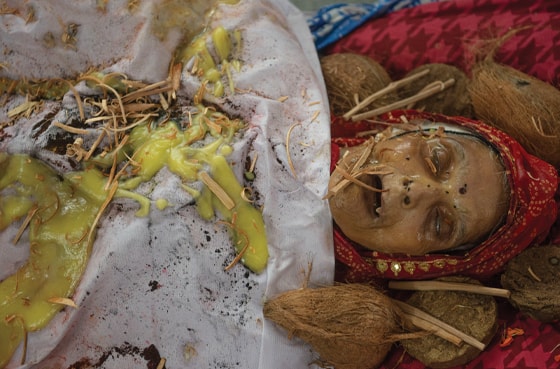
The next day we returned to the crematorium for a ritual called Asti Kalash, where we picked out my mother’s astis (bones) from the ash. Colloquially this is also called Phool Chun na, which translates to “picking out the flowers.” What an incredible metaphor, I thought. To someone else, it may look like a pile of human bones, but to me, they were precious remains of my mother worthy of worship.
My brother, my father, a few of my uncles, and I performed the washing of the bones. The meaning of family was more real than reality itself. These were people I grew up with and shared many a celebratory hug, but today they sat on the floor with me to hold my hand and pack my mother’s remains. Ritual by ritual, I felt transformed.”¯”¯
On the sixth day, we took my mother’s remains to the city of Nasik, where many of my ancestors’ final rights had been performed. Upon arrival on the banks of the Godavari River, my father uttered my grandfather’s name, Tilak Raj Sharma, and within minutes, multiple priests were looking through delicate handwritten location-tagged logs called the Bhrigu Shastra. These records contain the names of every person who traveled to these banks for their Asti Visarjan, or immersion. A frenzied crowd surrounded us, but amidst the chaos, a priest said, “Are you the descendent of Agyaram Sharma?” This was the name of my paternal great-grandfather. I am still puzzled by the speed with which we found our priest, but the single goal of priests hovering around these pilgrimage sites is to reconnect with the families they are meant to karmically and ancestrally perform these final rights for.
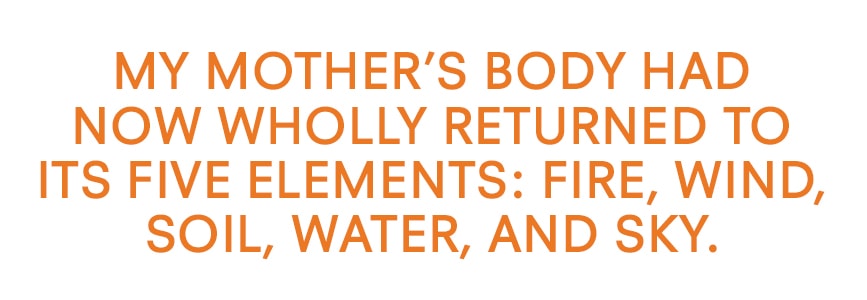
This priest’s life was tied to ours by way of death. He was somehow connected to my great-grandfather, my grandfather, my grandmother, and my aunt. Now he would perform final rites for my mother. My brother and I walked through the gushing water and were ushered onto a platform where we held hands with my father, chanted, and released my mother’s astis into the water.
Rituals work on the assumption that nothing, however small and insignificant or vastly incomprehensible, is without significance to our destiny in this ever-moving world. My mother’s body had now wholly returned to its five elements: fire, wind, soil, water, and sky.
On the tenth day was a ritual called Pindadaan. Much to my surprise, we met in a location that looked unkempt, raw, and gritty. After the previous day’s soul-cleansing experience with the water, I was disappointed.”¯
Our pandit said, “Today we will be conducting a prayer ceremony that symbolically focuses on her “˜birth’ and figuratively brings her back to life.” We were meeting in this location because birth is gritty and messy. I was asked to make a dough from rice flour, ghee, and black sesame seeds. As I pressed into the dough, I thought of the countless times my mom kneaded fresh dough to make me roti. I then rolled the dough into sixteen balls, known as pindas. Ten of them would symbolically represent parts of her body and act as a medium to reconstruct her in our mind so she could begin her journey to reunite with her ancestors. The remaining six symbolized the food she would need for nourishment for this transformation and journey.
We decorated each of these pindas, creating an abundance of beauty through texture and harmony to nourish our imaginations and broken hearts.”¯
With my mother now symbolically resurrected, our period of mourning had officially ended.
The final act, the Sapindi, involved the pandit making sixteen pindas again. My mother, in this newly revived form, would now begin a yearlong yatra, or journey, to reach moksha, or heaven. The journey would be long and tiresome, and my mother would halt at sixteen different villages where she would need food and care that we as a family would provide. The pindas represented these sixteen resting points, and this entire ritual represented her new life and spiritual journey onward. My father would now feed and care for my mother once a month by way of donating food to another woman her age. This woman will symbolically eat on behalf of my mother.
Drawing invisible lines of connection between my mother and us, we lifted my mother’s photograph to take in her blessings and asked my mother to leave her imprint on our hearts. The priest chanted an invocation that summoned all five types of wind that entered us through our eyes, nose, ears, mouth, and mind. These rituals made me feel cosmically united with my mother in the most elemental of ways. My father, in that moment, said, “I feel that Kiran is in us and with us.”
In twelve days, we had cremated my mother, handpicked out her precious bones, immersed her into sacred waters, rebirthed and re-manifested her spirit in our minds, and invoked and activated her journey onward.
Despite being born and raised in India and being deeply connected to my mother’s thirst for spiritual knowledge, I stood in complete awe of the transformation I experienced through the lens of these Hindu rituals. Thank you, mother, for teaching me that the silver lining of the silver lining is to seek and seek because our evolution is eternal.”¯
About the Contributor
Manjari Sharma makes art that addresses issues of memory, identity, multiculturalism, and personal mythology. Her work has been featured in the New York Times, Vice, Los Angeles Times, Huffington Post, CNN, and NPR, and her art is in the permanent collections of the Metropolitan Museum of Art, Museum of Fine Arts, Houston, Carlos Museum, and Birmingham Museum of Art. Originally from Mumbai, she now lives in Los Angeles.
Image Credit
Photographs by Manjari Sharma


